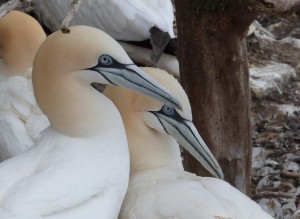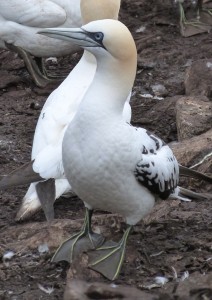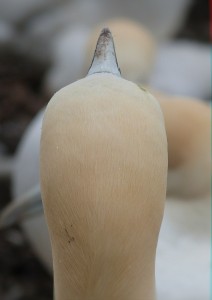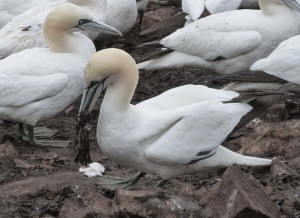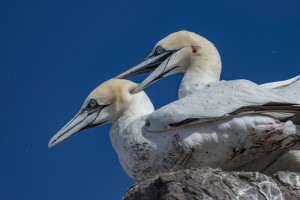Who’s the daddy?
By Jude Lane on Tuesday, March 8th, 2016
The gannet research blog has been quiet over the last 6 months … the gannets left the colony at the end of the summer and I returned to Leeds to make a start analysing some of the data we collected. Until now there hasn’t really been too much to blog about, my days have mostly been filled with the joy and frustration of learning how to use a piece of very useful open source software called R which is integral for my analysis. However, for the last few weeks I’ve been enjoying a change of scenery working at the University of Sheffield.
What am I doing in Sheffield? Well, with another few months before I can get back out on the Bass to work with the gannets, I’m spending some time at the NERC (Natural Environment Research Council) Biomolecular Analysis Facility establishing whether the birds we tagged last summer were male or female.
Despite the fact that gannets, like many seabirds, are a monomorphic species (by this I mean male and females look identical) differences in their foraging behaviour have been discovered. Researchers from the University of Exeter found that male gannets from the Grassholm colony are more likely to forage off fisheries discards than females, whilst a recent paper published on the Bass Rock gannets demonstrated that female gannets make longer (in time and distance) foraging trips than males and that they are more likely to be associated with tidal mixing fronts. This is fascinating stuff but we don’t know the reason for these differences, especially considering the two genders are so physically similar.
- Who’s the daddy? Male and female gannets are virtually identical in plumage and morphology
So given that males and females look identical, how is it that we are able to undertake these sex based comparisons? Work by a number of authors in the 60’s, 70’s and 80’s suggested that the sexes could be told apart through a number of subtle morphological and behavioural differences. These included the colour of the head plumage, the colour of the web-lines on the foot, the collection of nest material and a behaviour known as nape-biting.
- Web-lines on the feet tend towards deep turquoise-green in females and lime-green or yellow in males
- Head plumage can change from deep yellow to pale yellow during the breeding season in females
- Collection of nesting material is carried out mainly by males but females can also join in
In 2000, these criteria were evaluated alongside DNA profiling from blood samples. The results of over 500 hours of observations at each nest found the only reliable non-molecular method for sex determination is nape-biting. It is only the males which will display this behaviour. You can find the paper here if you’d like to read more about what they did.
- A male nape-biting his female partner on his return from a foraging trip. It is only males who display this behaviour. Photo credit: Sam Hobson
So we can reliably tell males and females apart by observing nape-biting. The only down side to this is that it only occurs when there is a change over at the nest. With foraging trips averaging around 24 hours in length you would have to live on Bass all summer in order to have a chance of observing this at every nest you are monitoring. This is why I am now in the Molecular Ecology lab in Sheffield learning how to determine sex using a DNA-based method.
If you’re interested, my next post will give you a bit more detail about the how we go about doing this.




